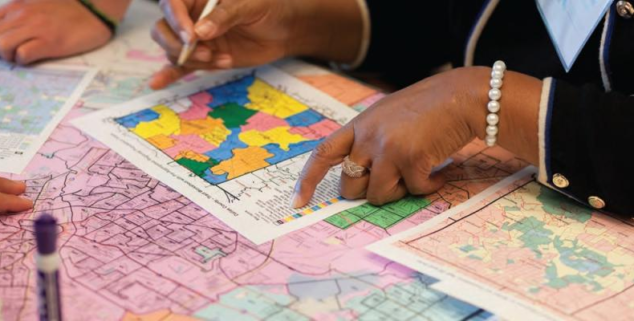News
Women shatter glass ceiling on redistricting commission
 A woman ponders a map and potential political districts. (Photo: League of Woman Voters of California)
A woman ponders a map and potential political districts. (Photo: League of Woman Voters of California)Next year, when California lays down political boundaries for a new decade, it will become the first state ever to adopt lines drawn in public by a commission in which women are the majority, election experts say.
There have been women Assembly Speakers and Senate ProTems — traditional arbiters of district lines and political fortunes — but none wielded the gavel during the once-a-decade year in which district boundaries are redrawn to comport with fresh Census figures. And the only previous Redistricting Commission was majority male (although the technical team was entirely female).
“It was just such an old-boys club.”– Karin Mac Donald
For generations, drawing lines to bolster or destroy political fortunes was the exclusive purview of powerful politicians, those in the right office at the right time — all of whom were men.
Even women consultants, the people who grasp the fineries of this esoteric world perhaps better than those who make decisions, were few and far between.
“It was just such an old-boys club,” said Karin Mac Donald, whose all-woman consulting team drew the lines adopted by the male-majority, voter-approved California Citizens Redistricting Commission in 2011.
“In the 90s, I would go to conferences and I was the only woman there,” she recalled. “There were just very few women in redistricting until we came along.”
Sadhwani said the significance of a female-majority Redistricting Commission is especially resonant on this hundredth anniversary of women’s suffrage.
The subsequent transformation is remarkable. Women’s role in setting the political playing field for America’s most populous state has gone from next-to-nothing 20 years ago to majority vote today.
“They not only broke the glass ceiling,” said California redistricting expert Mike Wagaman, “they obliterated it.”
Dr. Sara Sadhwani is among those obliterators, and says it’s “an absolute honor to be in the majority” on the Commission, comprised of eight women and six men.
A number of states have redistricting panels and 10 states have independent commissions, which means they limit the direct involvement of lawmakers. Those are Alaska, Arizona, California, Colorado, Hawaii, Idaho, Michigan, Missouri, Montana, and Washington.
Sadhwani said the significance of a female-majority Redistricting Commission is especially resonant on this hundredth anniversary of women’s suffrage “and as we see our first female vice president.”
Sadhwani was picked at random from a shortlist put forward by Democrats, in an unusual selection process involving the mechanical extraction of numbered ping pong balls from a hand-spun bingo cage. The eight partisan members picked in that manner then chose their remaining six colleagues with an eye to balancing regional, ethnic and ideological perspectives.
“We are certainly a diverse group based on backgrounds, ages, opinions,” she said. “I think it is particularly special that we have this majority. It is, I think, something unique.”
Sadhwani said the shift “is reflective of American politics in general, and I think it’s reflective of our changing times.”
Unsurprisingly, Hertzberg portrays his role in 2001 not as the end of the backroom era, but as the beginning of the open-government era.
Sen. Robert Hertzberg, D-Van Nuys, was Speaker of the Assembly the last time politicians drew the lines for California, and holds the distinction of being the last person to do so still in elected office.
“I’m the last one,” he said. “The last one to do redistricting.”
Unsurprisingly, he portrays his role in 2001 not as the end of the backroom era, but as the beginning of the open-government era. Although closely watched by politicians and the Capitol community, redistricting is all but ignored by the general public.
Hertzberg’s role, as he explains it, was transitional. Although he held enormous sway over the lines that determined boundaries of 80 Assembly and 40 Senate districts in 2001 (and the fates of sitting members, not all of whom emerged unscathed), he said he was constrained from blatant gerrymandering, in part by changed laws, in part by court rulings, and in large part by the microchip.
“You could not play games with technology,” he said. “You just couldn’t do it anymore. You could draw a few lines here and there … but with the technology, any judge can look at the technology.”
“I was a term-limited Speaker” he noted. If the courts tossed his lines after his term was up, there would be no second chance. His opportunity to leave a decade-long thumbprint on California politics would have been lost forever. To prevent that, “I literally had a lawyer go over every line.”
The result was a political map that for the most part withstood scrutiny and court challenges. It held until the commission adopted new lines in 2011.
But the days when Speakers or ProTems drew lines with impunity, Hertzberg insists, had ended before he arrived.
“The ‘bad old days,”’ he said, “was literally guys with pencils.”
Want to see more stories like this? Sign up for The Roundup, the free daily newsletter about California politics from the editors of Capitol Weekly. Stay up to date on the news you need to know.
Sign up below, then look for a confirmation email in your inbox.

Leave a Reply